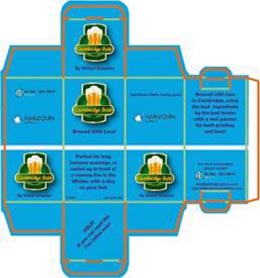New Features for Labels and Packaging in Latest Harlequin Release
Press release from the issuing company
Cambridge, UK – The latest update to the Harlequin RIP®, Version 12.1, the print engine that drives the industry’s highest performing digital presses, is announced today by developers Global Graphics Software.
Harlequin Version 12.1 introduces additional features for labels and packaging workflows, notably support for the new ISO standard for processing technical marks, and expanded support for systems requiring multiple RIP instances to handle high data throughput requirements.
PDF Processing Steps (ISO 19593?1) is a new industry standard designed for labels and packaging workflows, that specifies a standard way of encoding processing steps such as die and fold lines or dimensions into a PDF file. It provides an unambiguous way of marking the technical content that’s required in the finishing step of the production workflow but not intended to be printed.

PDF Processing Steps promises the ability to control technical marks without needing to analyze each file and create a different setup for each job.
“You can say to Harlequin 12.1 ‘just give me the design content in the PDF with no processing steps’,” says Martin Bailey, CTO at Global Graphics Software, “or ‘just give me structural processing steps and nothing else’, without needing to know what name the designer assigned to each item. Prior to the formulation of this ISO standard designers could use ad hoc naming conventions and methods to describe a processing step which increased the risk of error and of wasting material.”
The benefit to converters is that they can automate common digital press workflows, such as starting a print run with a few iterations of just the cut and fold lines for checking registration with dies and other finishing equipment. The main print run will then usually need all the processing steps turned off, so just the live graphics are shown and there’s no risk of cut lines being visible on the final print. A few more copies of just the technical separations may be printed at the end to detect if registration with cutters and converting equipment has drifted during the job.
Even higher speeds for inkjet
Harlequin 12.1 extends support for systems using multiple RIPs by introducing an expanded framework, called Harlequin Scalable RIP, that is designed to support press vendors in building higher and higher speed digital front ends to drive faster and faster presses. It gives press vendors access to a complete scale of solutions from a single RIP, through multiple RIPs on a single server, up to multiple RIPs across multiple servers.
“The highest data rate for an inkjet press is now an astounding 45GB per second and we already drive those presses through Harlequin,” says Bailey. “With the Harlequin Scalable RIP press vendors can bring high?quality, highly robust solutions to market even faster, and without significantly expanding their own development teams for their initial integration.”
Harlequin 12.1 also introduces seamless screening for repeats that are not simple rectangles, for example, for staggered imposition of hexagonal or rhomboid-shaped labels. It’s most commonly used for flexographic sleeves, or for non-publication gravure to avoid causing artifacts when the same screened raster is printed multiple times along the substrate without gaps in the graphics. The seamless screening can be applied to all screening types where the screening is applied by Harlequin itself, including spot function, threshold and tile-based.
Existing features for labels and packaging workflows
The Harlequin RIP contains a wealth of features already in use by converters in their DFEs such as:
- High-speed variable data printing, even when every item is different.
- Overriding overprinting for white and varnish
- Brand color matching
- Screening options for flexo, offset and digital production
- In RIP bar-code generation
- Dynamic overlays
- Export of contours such as cut and fold lines in vector format
Download the latest product brochure here: https://www.globalgraphics.com/harlequin
© 2025 WhatTheyThink. All Rights Reserved.













